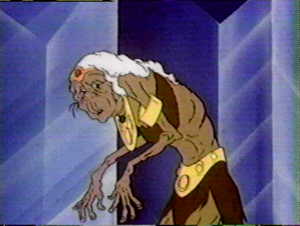
Hollywood has been a far from welcoming place for black people. The sheer number of major black performers today (from Whoopi to Wesley, Oprah to Denzel, Eddie Murphy to Angela Bassett) could make us forget the early Sixties, when major black actors could be counted on one hand (Sidney Poitier, Brock Peters, Ossie Davis, Ruby Dee, Harry Belafonte). Before that, forget it; you'd find Dooley Wilson or Butterfly McQueen or Hattie McDaniel or Mantan Moreland as a servant or a sidekick, but never telling their own story in their own right.
Things were no better for blacks in Toontown; worse, in fact. In the early Sixties, the most cutting-edge animated series of the day (the original "Jonny Quest") may have given us a major character of color (Hadji) but also kept alive a host of racist stereotype villains (only the James Bond movies would linger much longer in that muck). After Hadji, however, when did anyone ever see a prominent black animated character? One of Josie's Pussycats was black, but she seemed interchangeable with the others. There were one or two superheroes of color, but they basically stuck to the Superman model of having super powers rather than having a life. Most blacks in animation were ghettoized to all-black contexts (the Harlem Globetrotters, the Jackson Five and--the worst of all--Fat Albert and the Cosby kids).
There were two pockets of fresh air in this regard on network television. ABC ran "Kid Power", a short-lived series based on Morrie Turner's comic strip "Wee Pals". Like the strip, the series was not a case of token integration but an example of diversity and inclusion long before anyone started talking about political correctness.
And then there was Diana. A singular combination of beauty, talent and attitude, she was a major member of the D&D team throughout the three-year run of the series.
We probably know more about her, directly and by inference, than any of the others. (In this, although the writers pretty much decided what Diana would say and do, I have to give a lot of credit to Tonia Gayle Smith, who voiced Diana; apparently, she has not done any acting before or since (that I can find, anyway) but more than held her own among the professionals in the cast.) She tells Kosar in "Child of the Stargazer" that her father is an astronomer. She mentions to Josef Mueller in "The Time Lost" that she has a brother. Hank tells Kosar that Diana was the gold medalist two years running for high school gymnastics in her state.
This certainly accounts for her weapon: a staff that collapses to nearly nothing, or extends to become a javelin, a quarter-staff or a vaulting pole. It's generally referred to as a javelin, although Diana only uses it that way once: in "Traitor", Hank directs her to use it to plug the leak in the balloon. Occasionally used as a club, it's most often used to carry Diana across distances, or to send enemies away. This weapon is an extension of Diana's earthly life as an athlete.
There are also inferences that she's had equestrian experience. During "The Garden of Zinn", when others are frightened of a giant worm, Diana wonders aloud whether a worm can be saddle-broken. She then vaults up onto its back, using her staff to get the worm's attention and steer it toward the surface. Similarly, in "Cave of the Fairy Dragons", her first instinct when confronted with giant ants is to try to ride one. The same in "Child of the Stargazer", when she tries (unsuccessfully) to ride one of the giant bats of Queen Siris' men.
We also know she has the courage of a warrior as well as the body of an athlete. Deprived of her staff in "Dungeon at the Heart of Dawn", she fights off giant salamanders with just a tree-branch. Similarly in "The Traitor", when Eric is yelling about being attacked by twenty Orcs, her response is, "Alright, you take two, I'll take eighteen." Yet, for all that, she's not obstinately brave like Bobby, who would sometimes plunge into the fray against all odds or common sense. She knows when to run--usually, when the others do.
Her willingness to take Kosar's place in the Temple of Light must count as bravery of a kind. She didn't plan to do so until Kosar was wounded by the demon queen, but didn't hesitate when the time came.
We know she has a highly-developed sense of justice:
in "The Traitor", she stands by Hank the longest when the others suspect him of consorting with Venger;
she either doesn't know how the Third Reich felt about blacks, or knew but still was willing to be polite toward Josef Mueller in "The Time Lost";
she defends Sheila when Eric starts riding her supposed incompetence in "Citadel of Shadow".
We know from "Quest of the Skeleton Warrior" that Diana's big fear was--not getting old, but getting TOO old. To an athlete, infirmity, the body betraying the spirit, must surely be the harshest blow. To a girl of action like Diana, being too weak to wield her staff was surely a nightmare.
Above all, she's usually the one with the snappy comeback to Eric's put-downs of whatever he doesn't like. Even there, though, she is capable of rising to Eric's defense when it's deserved. When "Odyssey of the Twelfth Talisman" opens, she is seen luring a herd of camel-dragons into a river trap devised by Eric. When the others express amazement that the trap worked, she simply grabs Eric and says "Y'see?" The only way that line makes any sense is if she was the only one who thought Eric's plan might work.
Does all this make her too good to be true? In a sense, all the kids are, which shouldn't stop us from dealing with them.